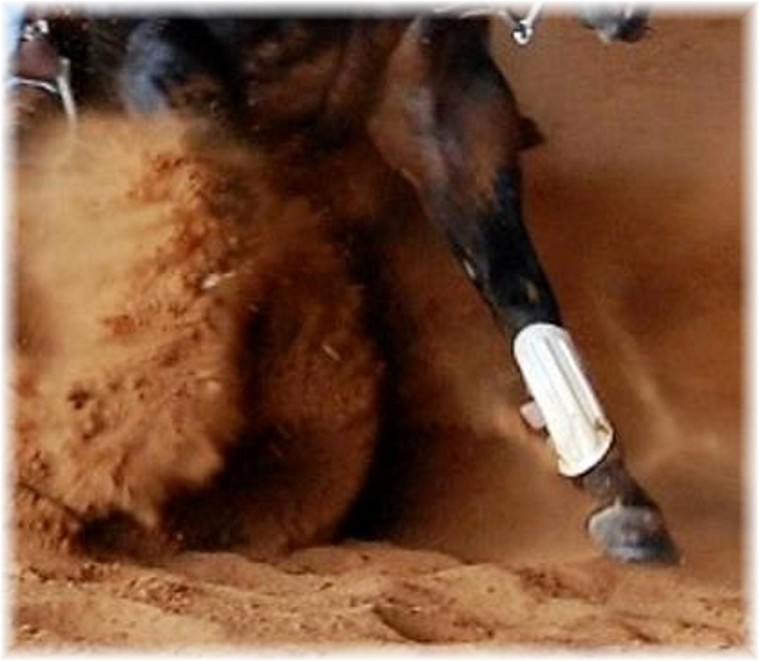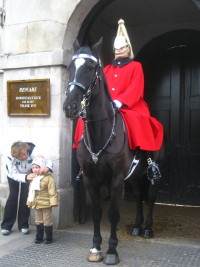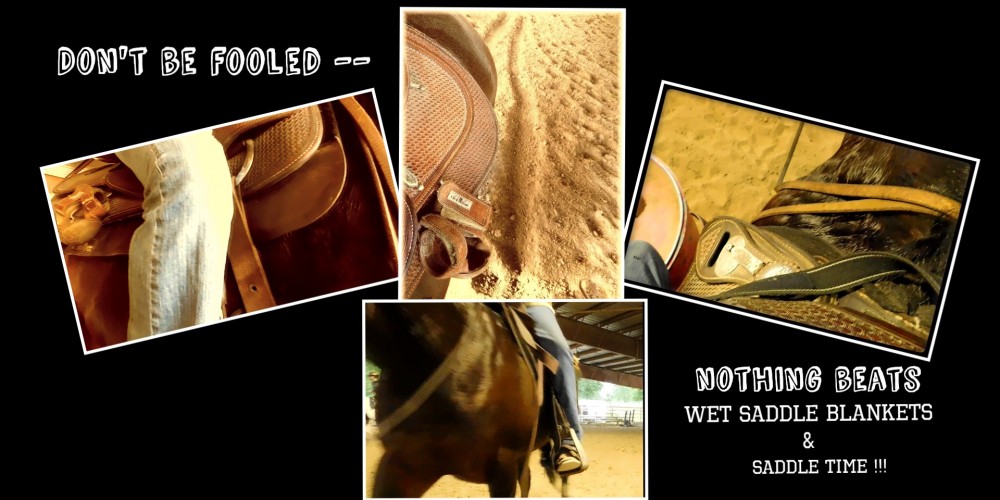
KIWI
PERFORMANCE
HORSES
REINING TRAINING, LESSONS
AND WESTERN SHOWING.
AND WESTERN SHOWING.
" Where Reining Horses Reign "
Welcome to Kiwi Performance Horses.
Teaching your horse patience!
Your horse may never have to stand as still, for as long, as this Queen's Horse Guard horse in London, England, but all horses need to learn how to patiently stand still in all sorts of situation – being groomed, saddled, when under saddle, in a show ring, waiting to show, having their hooves worked on, even out on the trail.
One of the most effective ways to teach a horse patience is to tie her up! If you’ve never tied your horse for any length of time, try the following.
After you’ve worked your horse and washed her down, you’ll probably head back to her stall where, if she’s anything like mine, she’ll want to chow down! Here’s where you change the routine.
Instead of letting her feed, clip her halter to a sturdy chain, about 2 feet long, positioned about half way down the stall, and on the opposite side to her feed. (Always consider your safety and that of the horse when positioning any kind of hitching post.) She won’t like this much and will throw all sorts of dirty looks in your direction! Ignore them and go do something else – get her feed bucket ready, get her hay, her supplements, fly sprays or whatever else you need to finish her routine – or just plain disappear! Take about 5-10 minutes, if she’s new to this.
When you get back to her stall, she’ll expect you to untie her – especially if you’ve emptied her grain into her feed bucket. They learn that sound very quickly! Wait. By now, she’s probably a bit upset and may be tossing her head, and pulling on the chain. Now is the time to reassure her, so love on her a bit. Rub her delicate area around the nose, scratch her ears, rub her cheeks, talk to her soothingly, and be ready. As soon as she calms down and stops pulling, untie her immediately and let her go to her feed.
Do this often and regularly, gradually increasing the amount of time she is tied, until you can leave her for extended periods of time without her fussing at all. You will have taught your horse to be patient when tied – and life will be safer and easier for both of you!
Of course you can follow the same technique if her routine is to be put out in a pasture - tie her and make her wait to go out - the principle works the same no matter what scenario you have.
Look for our next training tip – coming soon!
Getting Your Horse to Slow its trot.
I had a horse that was really not much more than green broke, despite being 7, when she had to go through a lot of training that she should have had years ago. One of our issues was the speed of her trot – get her up to a trot and she takes off at a million miles an hour. I loved the feeling but I was also envious of riders of more experienced horses who just gently trot – or lope – in nice, controlled circles at a nice leisurely pace.
One way to get a horse to slow down the trot, when under saddle, is to slow down your own breathing at a posting trot or sitting trot. Take a deep breath on the rise and then let it out slowly as you settle down deeper in the saddle. I found this a little difficult though, when she was going flat out, and I was trying to control her head as well as her speed. What would end up happening was me getting entirely out of sync with her stride – and coming home with a bruised butt!
At the same time, we spent weeks and weeks of just walking everywhere and if I started to feel her bunch up and want to take off, I’d rein her in a bit, to get her out of thinking she could just take off whenever she wanted. Over time I think she probably thought she’d never trot again!
I’d had enough walking too, so my trainer, Lilly King started me on a different training method. I’d pick my mare up to a trot, let her trot 5 or 6 strides, then stop her and make her back up. Do the same thing again, in a different direction – 5 strides, whoa, back up. We did this 10 or 11 times before letting her trot for longer, in a circle. As soon as she tried to head off in a straight line, or speed up, we’d teach her that wasn’t acceptable with the “whoa, back up, start again” routine. So she learned “well heck, if I take off running, I’m just going to be made to stop, so maybe it isn’t worth it. I’ll just go slow.” This really worked! There was still room for improvement. She still needed to go a little slower, but for the first time, I was able to trot her in lovely, controlled circles and really enjoy riding my horse!
Look for our next training tip – coming soon!
Happy riding!
Teaching your horse patience!
Your horse may never have to stand as still, for as long, as this Queen's Horse Guard horse in London, England, but all horses need to learn how to patiently stand still in all sorts of situation – being groomed, saddled, when under saddle, in a show ring, waiting to show, having their hooves worked on, even out on the trail.
One of the most effective ways to teach a horse patience is to tie her up! If you’ve never tied your horse for any length of time, try the following.
After you’ve worked your horse and washed her down, you’ll probably head back to her stall where, if she’s anything like mine, she’ll want to chow down! Here’s where you change the routine.
Instead of letting her feed, clip her halter to a sturdy chain, about 2 feet long, positioned about half way down the stall, and on the opposite side to her feed. (Always consider your safety and that of the horse when positioning any kind of hitching post.) She won’t like this much and will throw all sorts of dirty looks in your direction! Ignore them and go do something else – get her feed bucket ready, get her hay, her supplements, fly sprays or whatever else you need to finish her routine – or just plain disappear! Take about 5-10 minutes, if she’s new to this.
When you get back to her stall, she’ll expect you to untie her – especially if you’ve emptied her grain into her feed bucket. They learn that sound very quickly! Wait. By now, she’s probably a bit upset and may be tossing her head, and pulling on the chain. Now is the time to reassure her, so love on her a bit. Rub her delicate area around the nose, scratch her ears, rub her cheeks, talk to her soothingly, and be ready. As soon as she calms down and stops pulling, untie her immediately and let her go to her feed.
Do this often and regularly, gradually increasing the amount of time she is tied, until you can leave her for extended periods of time without her fussing at all. You will have taught your horse to be patient when tied – and life will be safer and easier for both of you!
Of course you can follow the same technique if her routine is to be put out in a pasture - tie her and make her wait to go out - the principle works the same no matter what scenario you have.
Look for our next training tip – coming soon!
Getting Your Horse to Slow its trot.
I had a horse that was really not much more than green broke, despite being 7, when she had to go through a lot of training that she should have had years ago. One of our issues was the speed of her trot – get her up to a trot and she takes off at a million miles an hour. I loved the feeling but I was also envious of riders of more experienced horses who just gently trot – or lope – in nice, controlled circles at a nice leisurely pace.
One way to get a horse to slow down the trot, when under saddle, is to slow down your own breathing at a posting trot or sitting trot. Take a deep breath on the rise and then let it out slowly as you settle down deeper in the saddle. I found this a little difficult though, when she was going flat out, and I was trying to control her head as well as her speed. What would end up happening was me getting entirely out of sync with her stride – and coming home with a bruised butt!
At the same time, we spent weeks and weeks of just walking everywhere and if I started to feel her bunch up and want to take off, I’d rein her in a bit, to get her out of thinking she could just take off whenever she wanted. Over time I think she probably thought she’d never trot again!
I’d had enough walking too, so my trainer, Lilly King started me on a different training method. I’d pick my mare up to a trot, let her trot 5 or 6 strides, then stop her and make her back up. Do the same thing again, in a different direction – 5 strides, whoa, back up. We did this 10 or 11 times before letting her trot for longer, in a circle. As soon as she tried to head off in a straight line, or speed up, we’d teach her that wasn’t acceptable with the “whoa, back up, start again” routine. So she learned “well heck, if I take off running, I’m just going to be made to stop, so maybe it isn’t worth it. I’ll just go slow.” This really worked! There was still room for improvement. She still needed to go a little slower, but for the first time, I was able to trot her in lovely, controlled circles and really enjoy riding my horse!
Look for our next training tip – coming soon!
Happy riding!


Make the start of working with your young horses a successful one with these valuable tips.
Are you in search of some pointers to help you start working with your young horses?
Several short learning sessions each day with your horse are better than one long session, and patience is key.
Wear a helmet; your safety is most important!
Teach your young horse to go, whoa, back and plow rein before mounting.
You can’t begin working with a horse too early in life, but be sensitive.
Several short learning sessions each day are better than one long session.
The American Quarter Horse Journal delivers stories, articles, statistics and information readers depend on for success in their horse business or hobby. Subscribe for yours today.
Lavish praise speeds up the learning process by 60 percent.
Always end each session on a good note, even if it means doing something very simple. It’s a win-win situation for you and the horse.
Leaning over a horse from a fence or hay bale will prepare that horse for seeing you overhead, and then in the saddle, which can be a shock.
Pay close attention to your horse’s diet .
Teach your horses to lead properly.
Learn the proper way to reprimand your horse, if necessary. Beginning with a “shhhhh” noise lets the horse know he is getting out of bounds.
Working with young horses requires its own set of rules. Their youth and inexperience needs attention and special instruction.
Are you in search of some pointers to help you start working with your young horses?
Several short learning sessions each day with your horse are better than one long session, and patience is key.
Wear a helmet; your safety is most important!
Teach your young horse to go, whoa, back and plow rein before mounting.
You can’t begin working with a horse too early in life, but be sensitive.
Several short learning sessions each day are better than one long session.
The American Quarter Horse Journal delivers stories, articles, statistics and information readers depend on for success in their horse business or hobby. Subscribe for yours today.
Lavish praise speeds up the learning process by 60 percent.
Always end each session on a good note, even if it means doing something very simple. It’s a win-win situation for you and the horse.
Leaning over a horse from a fence or hay bale will prepare that horse for seeing you overhead, and then in the saddle, which can be a shock.
Pay close attention to your horse’s diet .
Teach your horses to lead properly.
Learn the proper way to reprimand your horse, if necessary. Beginning with a “shhhhh” noise lets the horse know he is getting out of bounds.
Working with young horses requires its own set of rules. Their youth and inexperience needs attention and special instruction.
All tips or training methods shown on this page ARE only the opinions of others.
To undertake anything written OR shown on our web site is undertaken at your own risk.
Under Texas Law ALL Equine activities are done at your own risk and we are not Liable for any injury to you or your horse, or anyone undertaking an Equine activity either on the ground or on their back.
Please DO NOT attempt any training method that you do not understand or if you are a beginner.
ALWAYS IN-LIST THE HELP OF AN EQUINE PROFESSIONAL.
To undertake anything written OR shown on our web site is undertaken at your own risk.
Under Texas Law ALL Equine activities are done at your own risk and we are not Liable for any injury to you or your horse, or anyone undertaking an Equine activity either on the ground or on their back.
Please DO NOT attempt any training method that you do not understand or if you are a beginner.
ALWAYS IN-LIST THE HELP OF AN EQUINE PROFESSIONAL.
